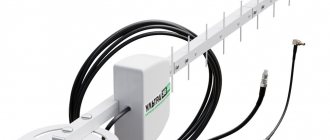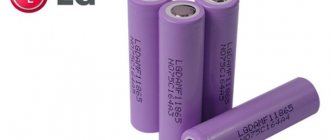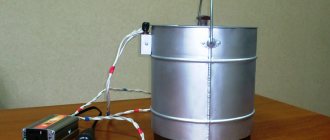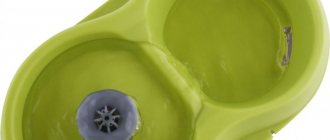Standard
A regular center punch is a metalworking tool made in the form of a handle equipped with a rod, for the manufacture of which special tool steel is used. The purpose of the center punch is to make small indentations in the surface of the metal into which the tip of a drill bit for a hand or electric drill will later be inserted. The punch tip is equipped with a cone-shaped sharpening specifically for the drill. The handle of the device is equipped with special notches. They prevent your hand from slipping while working with the tool. According to consumer reviews, the disadvantage of a conventional punch is that you have to work with two hands (hold a hammer in one, and a punch in the other).
For those who want to free one hand and exert a minimum of effort while working, it is recommended to use an automatic center punch. It can be mechanical, spring and electrical.
Device diagram
The tool contains a spring mechanism inside that drives the striker. The advantage of this modification is that, firstly, it allows marking with one hand, without the use of impact tools, and secondly, the impact force of such a center punch can be adjusted, which can be significant when working with soft or fragile materials or critical parts, requiring increased processing accuracy; marks on parts obtained using an automatic center punch have the same depth. Thirdly, the use of an automatic center punch allows you to increase the speed of marking.
Design of Gorin's mechanical punch
Some versions of automatic punches have a rubber or plastic cap on top that helps reduce the “recoil” in the master’s hand.
Spring center punch
A mechanical or spring center punch can be operated with one hand. This tool operates by tightly compressing and self-releasing a special spring.
Inside the body of this tool there is a cocking and trigger mechanism, which affects the firing pin and the working part of the capper. The cone-shaped rod performs punching by hitting it with a striker. It starts moving after the spring is released.
Do-it-yourself automatic center punch
Any metalworking operation is preceded by marking the part with lines and reference points deepened into the surface of the metal. The first ones are done with scribers, and for applying the second ones there is a special marking tool - a center punch. In general form, it is a small metal cylinder with a sharpened working end and a flat back.
GOST punches are made of rolled rods of alloy and carbon tool steels. In conventional punches, the marking point (core) is applied by hitting a hammer, while in mechanical automatic punches a spring and a striker are used for these purposes.
This tool has a more complex design, but is highly accurate and allows you to work with one hand. In addition to spring ones, there are automatic electric and pneumatic punching devices. They are much more expensive than conventional and mechanical punches, so they are used in industrial production with large volumes of marking work.
A specialized tool for applying cores allows automatic alignment on similar parts or cylindrical surfaces.
Benefits of the tool
Judging by the reviews of the owners of such products, the spring automatic center punch has the following advantages:
- Marking is done with one hand: no percussion instrument is used.
- The master has the opportunity to control the force of impact with a cone-shaped rod on a metal surface. This function, which the automatic mechanical punch has, allows you to safely process soft and fragile materials without the risk of damaging them: the same depth is a characteristic feature for all holes made by this tool.
- The marking procedure with a mechanical center punch is much faster than with a standard one.
Electric automatic punch
The operating principle of this tool is to use a striker and a rod, which are set in motion not by human effort, but by the action of an electrical circuit. With the help of a solenoid (inductance coil) and the created short-term magnetic field, the striker, being drawn into the tool body, releases the firing pin. That, in turn, affects the rod. As numerous consumer reviews testify, using such an automatic punch, you can make at least fifty holes within one minute. As users note, electric cores are rare. This is explained by the fact that these tools have an outdated design.
Electric punch
An electric punch can also be called an automatic punch. It contains inside a solenoid, which draws a spring-loaded striker into itself, due to which the material is struck.
Design of an electric punch An electric punch consists of a body, springs, a hammer, a coil, and a punch. When the tip is pressed on the material, indentation occurs and the electrical circuit is closed. The current passing through the coil creates a magnetic field, the striker is instantly drawn into the coil and strikes the punch rod. During the transfer of the punch to another point, the spring opens the circuit, and the spring returns the hammer to its original position.
Where can I buy the device?
You can purchase a center punch of one type or another at locksmith shops. Tools are also sold in the hand and power departments. The cores are cylindrical in shape and are easy to spot on the shelves. Before purchasing this tool, it is recommended to pay attention to what material it is made of and who its manufacturer is. If there are no identification marks on the core body, experienced craftsmen recommend refraining from purchasing this tool.
How to choose a core?
When choosing this locksmith tool, pay attention to the following points:
- What material is it made of?
- Appearance of the center punch.
- Find out the manufacturer of the selected model. It is better to give preference to products from well-known manufacturers.
- Core dimensions. They must be selected taking into account the diameter of the drill.
- Sharpening angle. If you need to drill a hole in a soft material or make particularly precise markings, then the sharpening angle of the center punch, as well as the drill itself, may be smaller.
- Price. When buying a center punch tool, do not go for cheapness and do not take a product without any identification marks.
Kerner rating
Since the center punch plays an important role in carrying out measuring and marking work, it would not hurt to familiarize yourself with the rating of the best models of such plumbing tools:
- KWB 9209-90
. This is a hand tool made by a German company that owns production facilities in China. Being light in weight, this punch is durable and reliable in operation. - STANLEY 0-58-120
. An American instrument made in France. It has increased impact resistance thanks to the square-shaped striker. The disadvantage is the heavy weight. - RENNSTEIG RE-430230
. This is an automatic metal punch made in Germany. Has a comfortable rubberized handle. - JTC 3927
. A relatively cheap option made in Taiwan, which can be used for one-time work. - BISON Expert 21420-10
. The automatic center punch is manufactured in Russia. Easy to use and makes high-quality holes.
German manufacturer
Rennsteig produces contact crimping pliers and impact tools. Chisels, chisels, picks, drifts and punches manufactured by this company are united by high German quality.
Using the Rennsteig automatic punch, marks can be easily made along the marked line. To do this, place the tool in the desired location and press the cap. The punch works itself, without the use of impact devices.
Characteristics
The German product Rennsteig is an automatic center punch, the device of which consists of the following elements:
- Housing made of very high quality tool steel. It has a nickel plating.
- Replaceable hardened tip. Its length is 1.25 cm.
- Drummer. Its diameter is 0.14 cm.
The center punch is also equipped with a mechanism for adjusting impacts.
Using this tool, you can mark both ordinary steel and products made of any non-ferrous metal.
How to make a core with your own hands?
Those craftsmen who love to craft can try making a center punch with their own hands. This locksmith tool will save money and will be in no way inferior to a factory product, and it can be made, for example, from an ordinary bolt with a diameter of 14 mm. The core production work consists of the following stages:
- We clamp the bolt on a lathe and grind its end into a cone, sharpening the lower edge.
- We weld a piece of reinforcement or steel rod to the middle of the bolt.
- We put a wooden handle on the edge of the workpiece, which you can remove from an old file or chisel, or you can make it yourself.
- We harden the pointed end of a homemade center punch. To do this, heat the tip of the bolt on a gas burner and then dip it into a vessel with mineral oil.
- Allow the product to cool and you can use the resulting plumbing tool, which will be useful in any home workshop.
Do-it-yourself automatic center punch
Those who want to get a device for markings, but at the same time save money, or just those who like to tinker, can try to make a standard core. A regular diesel injector is suitable for this purpose, namely its shut-off needle, which is highly hard. It can freely core plastic, aluminum, copper, brass, bronze and high-carbon non-hardened tool steels. For those who want to work without using hammers, it is better to make an automatic core from a duralumin pipe. To work you will need:
- A duralumin pipe with a diameter of 0.12 cm. It will become the body of the future product.
- Shock-cocking mechanism. It is a cone-shaped product made of durable carbon steel, which is located at a slight offset inside the charging spring.
- Ordinary spring. It should be placed between the striker and the core plug.
- Cover or plug. It acts as a stop for the trigger spring, which acts on the firing pin.
- Striker. It is easy to sharpen it yourself using a sharpening machine or grinder.
- Sharpened cone-shaped rod. There may be several of them. In this case, if necessary, during work they can be removed and sharpened one by one.
Automatic center punch
Hi all. Today's review will focus on an automatic center punch that I purchased on eBay. If you suddenly decide to drill into hard metal or a material with a smooth, even surface, the drill may slip from the intended point, leaving behind a fairly decent scratch. To avoid such situations, a center punch is used, which makes a small depression (hole) in the surface of the material being processed. As a rule, a punch is a metal rod made of carbide steel. One end of it is pointed, and the other is “butt”. We place the point in the place where we need to drill a hole - hit the “butt” with a hammer and the hole is ready. Simple, but not always convenient, since firstly you need to use both hands, and secondly, constantly carrying a hammer with you is also not a good prospect. To simplify the process, an automatic center punch was created. But first things first. So, I ordered this product quite a long time ago, although I only got around to writing a review now. But during this time I managed to test the tool in almost all possible situations and so far nothing has broken, which is good news. If you are interested, you can see the route of the parcel from China to Belarus here.
Today's review will focus on an automatic center punch that I purchased on eBay. If you suddenly decide to drill into hard metal or a material with a smooth, even surface, the drill may slip from the intended point, leaving behind a fairly decent scratch. To avoid such situations, a center punch is used, which makes a small depression (hole) in the surface of the material being processed. As a rule, a punch is a metal rod made of carbide steel. One end of it is pointed, and the other is “butt”. We place the point in the place where we need to drill a hole - hit the “butt” with a hammer and the hole is ready. Simple, but not always convenient, since firstly you need to use both hands, and secondly, constantly carrying a hammer with you is also not a good prospect. To simplify the process, an automatic center punch was created. But first things first. So, I ordered this product quite a long time ago, although I only got around to writing a review now. But during this time I managed to test the tool in almost all possible situations and so far nothing has broken, which is good news. If you are interested, you can see the route of the parcel from China to Belarus here.
A live core is not much different from what can be seen on the seller’s page and looks like this:
In addition to the appearance, the seller’s page also contains the characteristics of the core:
Material: High speed steel material HSS, Hardness up to HRC58 - 60; Color: gold + red; Total length: about 125mm; Style: Conical; Use: industrial; Load type: compression; Red ball-shaped plastic handle for shock absorption, good for hand gripping; Can be used for marking, punching, breaking and scribing on wood, metal and plastic, can also be used for breaking glass.
This tool also has a more budget-friendly version - without the red plastic handle. It just seems to me that due to the fairly stiff spring, it will not be very convenient to use them. So it’s better not to save money here, especially since this implementation cannot be called expensive.
The total length of the core is 128 millimeters.
The diameter of the brass handle is 11.5 millimeters. The handle is covered with a corrugated pattern, thanks to which the core does not slip at all, even in a wet hand. So it is equally comfortable to use it even in the rain, even after bathing in an oil bath 
The diameter of the needle is almost 4 millimeters.
So its overall dimensions are not that large, and with a weight of only 77 grams, the core can be considered a more than compact tool (taking into account the fact that a hammer is not required to use it). It can be easily placed in a pocket or small bag, which improves mobility while working, say, on the roof or in other difficult conditions.
Despite its apparent simplicity, the core device can hardly be called elementary. There are 8 parts in total.
To make it easier to understand how it works, here is a diagram of the design of such a tool:
To put it simply, in order to core the place where the hole is made, you need to place the needle at the desired point and press the core from above, at a certain moment a click will be heard and the tool will do its job. It works by compressing and then sharply releasing a shock spring, which sets the firing pin in motion, striking the mate and then the needle.
A bias spring is installed on the mating part of the side that rests on the needle, which is compressed under load.
Due to the fact that its diameter is narrower on one side and wider on the other, the movement of the striker’s counter part occurs with an offset relative to the center. That is, roughly speaking, its shank rests against the edge of the striker. The striker, in turn, has a hole on one side that acts as a trigger mechanism.
At a certain moment, the shank of the impact part is centered and falls into this hole.
The load applied to the striker from the side of the needle disappears and the shock spring does its job - sharply releasing, the striker strikes the counterpart, and that, in turn, strikes the needle, which is why the mark is obtained.
The shock spring is located under the red plastic part so it can be used to adjust the shock force, which is important.
In principle, there is nothing more interesting and useful either in the appearance or in the design of this instrument, which means we can move on to its practical tests.
To begin with, a Soviet-era hammer was used as a test subject:
"Holes" on closer inspection:
As you can see, they are all neat, approximately the same in both diameter and depth. And, most importantly, one mark takes 1-1.5 seconds, no more.
Duralumin:
Just for fun, I tried it on a regular board :):
It didn’t break through, but the marks were more than decent.
And here is a short video on how it all looks in real life (I apologize right away for the focus - my camera can’t focus as well as I would like, but the essence of the process is clear):
To sum up everything that was written here, I can say that the instrument met all the expectations placed on it. It is trouble-free in operation, and besides, using an automatic core is much more convenient and faster than a regular one. True, at first the punch sometimes jammed and it was necessary to disassemble and reassemble the striking part in order to restart the process. Installing the eccentric spring in reverse helped to get rid of this problem. So, if you have to make holes in hard steels, ceramic tiles, etc., then you can consider this product as an upcoming purchase. It is not expensive, but at the same time it will really reduce the time of work and the integrity of the surface of the material being processed.
That's probably all. Thank you for your attention and your time.
Progress
It is not difficult to make an automatic core yourself if you work in stages. The wizard is required to perform the following actions:
- Make a punch rod. It is desirable that it have a diameter of 0.4 cm and a length of 4 cm. The working surface must be hardened.
- A shock-absorbing washer is installed on the striker shank. After this action, it is considered ready for use.
- Prepare the firing mechanism. To do this, install a machined part in the form of a cone in the inner part of the spring. This work should be performed in such a way that the thin part (0.3 cm) of the part rests against the end of the striker. Its length can be 3 cm.
- Insert the trigger mechanism into the body of the future tool.
- The upper part of the pipe closes silently at the end. For this purpose, the tube is equipped with a thread onto which the cap is screwed.
As a result, a homemade punch should act as follows:
- A sharpened cone-shaped rod is placed at the intended location for punching, after which it should be pressed.
- With its second blunt end it acts on the trigger mechanism: it pushes a cone-shaped part installed in the spring towards the firing pin.
- As a result of pressing the rod on the trigger mechanism, its cone-shaped part gradually moves more and more from the end until it hits the center of the firing pin. He, being under the influence of an ordinary spring, performs the blow.
The manufacture of a product can be considered successfully completed if, when the rod is pressed at the desired point, a mark is immediately formed on the surface. As numerous reviews from owners testify, it is convenient to store homemade cores and cores in chess boards. There, for each rod, you can make special sections made of polystyrene foam.
Homemade cores, both conventional and automatic, are the optimal solution for those who use this tool only occasionally.
What is a center punch?
Those who are familiar with plumbing know what a center punch means. This is a special impact-cutting tool for marking holes called cores. They are made before drilling holes and prevent the drill or screw from slipping from the intended point on the workpiece. This device can core metal, tiles and any smooth surface. The punch must be very durable, so this device is made of hard tool carbon steel.
Core device
A metalworking hand tool, popularly called a poke or core, has the form of a rod with a round or hexagonal cross-section. Its working end is sharpened into a cone having an angle of 100-120° and hardened to a length of 20-30 cm. The sharpening angle is an important indicator: a tool with a sharpened edge is convenient if precise marking of parts is required, and a center punch with a blunt end will facilitate easier drilling metal.
The opposite part of the center punch is the so-called buttplate or firing pin. It bears the brunt of the impact during the operation of the punch, so it is also hardened, but to a length of up to 15 cm. To make the punch more convenient to hold in the hand, its middle part is often made with a special relief knurling (notch). To extend the service life in adverse conditions, decorative and protective coatings in the form of chrome plating can be applied to the marking device.











